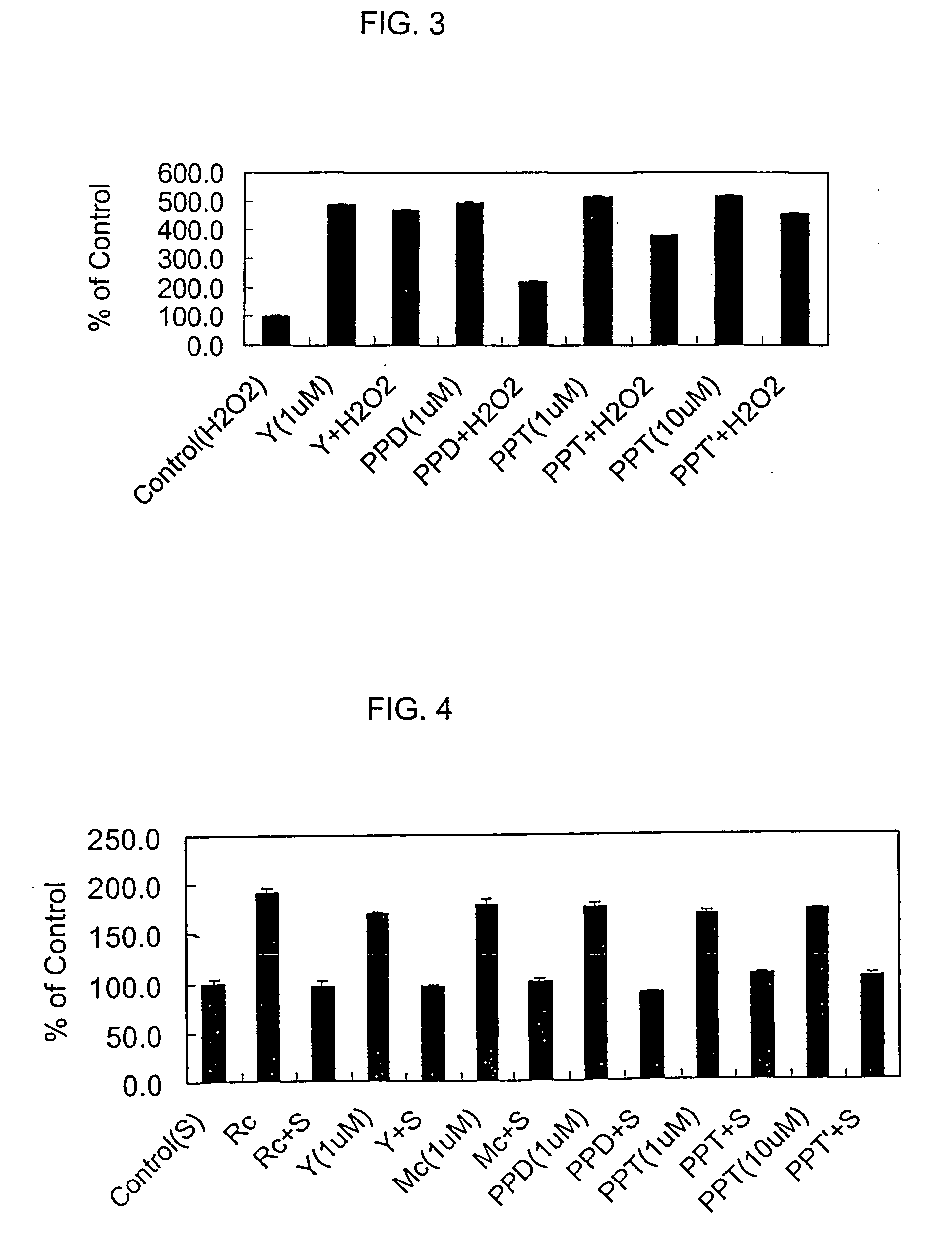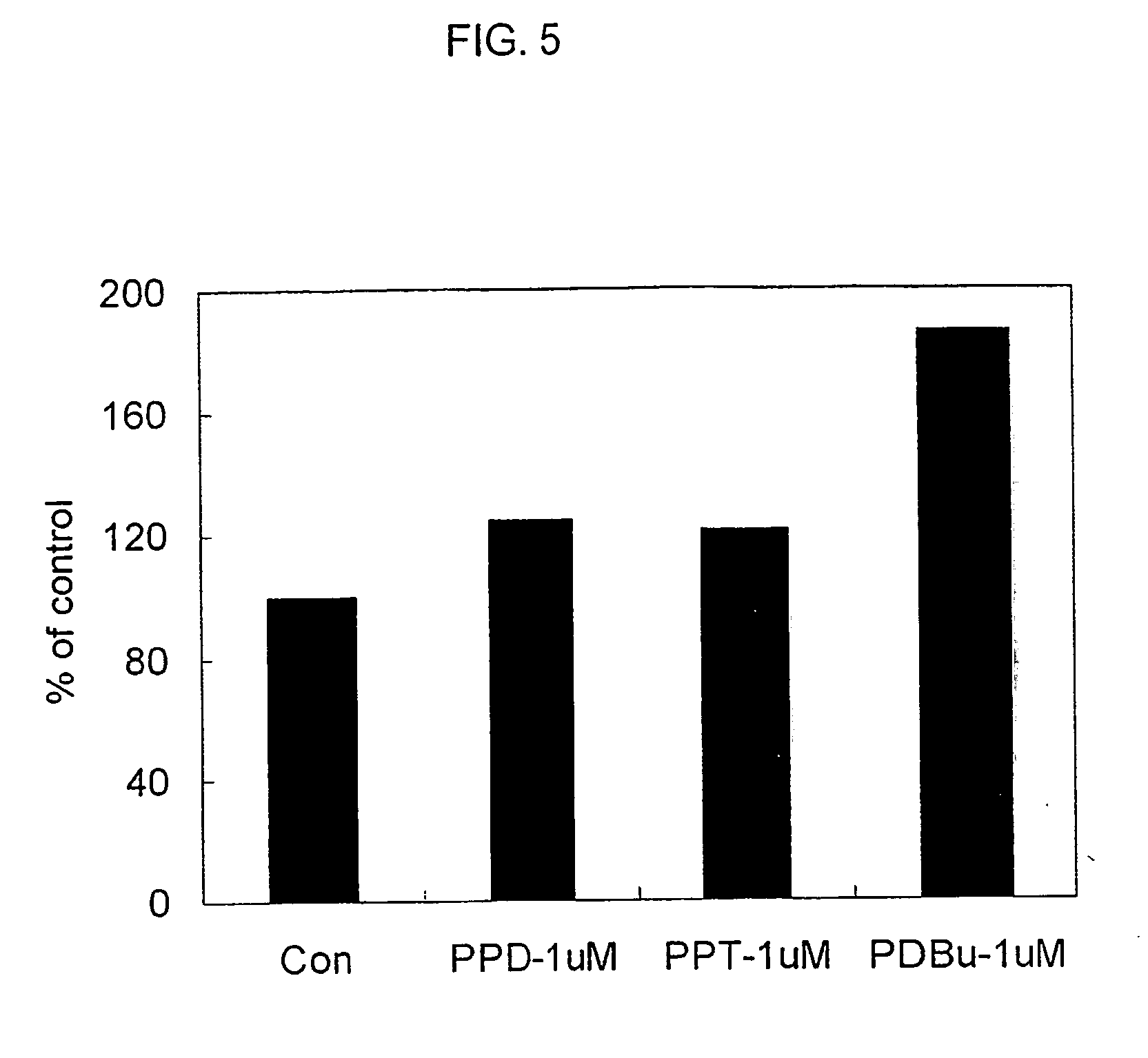Composition for preventing or treating degenerative brain diseases comprising a hydrolysate of ginsenosides
a technology of ginsenosides and brain diseases, applied in the direction of biocide, drug compositions, nervous disorders, etc., can solve the problems of reducing the effect of ginsenosides on the brain, affecting the function of brain cells, so as to prevent the beta-amyloid toxicity
- Summary
- Abstract
- Description
- Claims
- Application Information
AI Technical Summary
Benefits of technology
Problems solved by technology
Method used
Image
Examples
example 1
Effect of Preventing the Toxicity of Beta-Amyloid
[0042] In order to examine the activities of the compounds prepared in the Reference Example in preventing the toxicity of beta-amyloid, the MTT analysis (Gillardon, F. et al., Brain Research. No. 6: pp. 169-172 (1996)) was carried out as follows.
[0043] 5×103 cells of neuroblastoma B103 cell line (donated by Dr. David Schubert of the Salk Institute, USA) were placed in each well of a 96-well plate with 100 μl of DMEM (Dulbecco's Minimal Eagle's Medium) containing 10% fetal bovine serum (FBS), and cultured at 37° C. under 8% CO2 for 1 day. After changing the medium to serum-free DMEM, the cells were treated with various concentrations of test compounds and, 1 hour later, with 25 μM of beta-amyloid (25-35 peptide; US peptide, CA, USA). The cells were cultured at 37° C. for 18 hours, treated with 15 μl of MTT solution [10 mg / ml solution of 3-(4,5-dimethyl-2-thiazolyl)-2,5-diphenyl-2H-tetrazolium bromide in phosphate buffered saline (PB...
example 2
Anti-Oxidative Effect
[0047] The prevention of beta-amyloid toxicity has been proposed to be attributable to the blockage of oxidative stress (or damage of cells by free radicals) or the blockage of apoptosis (Becl, C. et al., Cell, 77: pp817-827 (1994); Yamatsuji, T. et al., Science, 272: pp1349-1352 (1996)).
[0048] In order to examine whether compounds originating from ginseng can block oxidative stress, the procedure of Example 1 was repeated except for using 1 μM of H2O2 in place of beta-amyloid, and the survival rates of the neural cells were determined. The results in Table 3 and FIG. 3 show that the test compounds prevented neuronal death caused by H2O2 and, accordingly, can act as anti-oxidative agents.
TABLE 3 Concentration of testTest Compoundcompound (μM)Survival rate (%)H2O2 1100Y 1486.5 ± 2.1Y + H2O21 + 1469.1 ± 5.2PPD 1494.3 ± 3.5PPD + H2O21 + 1219.6 ± 3.0PPT 1516.1 ± 1.6PPT + H2O21 + 1381.3 ± 0.9PPT10516.5 ± 1.2PPT + H2O210 + 1 457.8 ± 2.5
[0049] Further, in order to ...
example 3
Increase in Secretion of sAPPα (α-Secretase Derived Secreted Form of Amyloid Precursor Protein)
[0051] In order to examine whether the ginseng-originated compounds can inhibit beta-amyloid production, the activity of α-secretase, which cleaves beta-amyloid, was examined.
[0052] 1×106 cells of neuroblastoma B103 cell line (donated by Dr. David Schubert of the Salk Institute, USA), which secretes APP (amyloid precursor protein), were plated on a 100 min dish with 100 μl of DMEM medium containing 10% FBS (Fetal Bovine Serum) and cultured overnight at 3° C. under 8% CO2. The medium was replaced with serum-free DMEM (Gibco, USA), and PPD, PPT or PDBu (phorbol-12, 13-dibutyrate: Sigma Co., USA) was added thereto at a concentration of 1 μM each. The cells were cultured further for 18 hours. The supernatant was isolated from each culture solution and concentrated through a concentration filter (viva spin centricon, obtained from: Vivascience, Binbrook Hill, Binbrook, England). The concentra...
PUM
| Property | Measurement | Unit |
|---|---|---|
| Volume | aaaaa | aaaaa |
| Volume | aaaaa | aaaaa |
| Volume | aaaaa | aaaaa |
Abstract
Description
Claims
Application Information
 Login to View More
Login to View More - R&D
- Intellectual Property
- Life Sciences
- Materials
- Tech Scout
- Unparalleled Data Quality
- Higher Quality Content
- 60% Fewer Hallucinations
Browse by: Latest US Patents, China's latest patents, Technical Efficacy Thesaurus, Application Domain, Technology Topic, Popular Technical Reports.
© 2025 PatSnap. All rights reserved.Legal|Privacy policy|Modern Slavery Act Transparency Statement|Sitemap|About US| Contact US: help@patsnap.com



